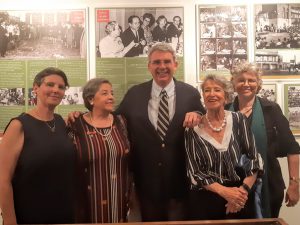CULTURE Beit Italia, 60 years of social commitment
To a simple visitor, Beit Italia looks like a complex consisting of little buildings that could act as a school, thanks to its being continuously kept tidy with renovations and structural improvements.
There is a courtyard in the middle, you can guess the schoolrooms by only looking at the windows, and a fence surrounds the whole building making it a safer place. Beit Italia celebrates its 60th anniversary, though it can be considered either younger or older depending on how you look at it.
In order to celebrate the anniversary, an exhibition was officially opened yesterday by Gianluigi Benedetti, Ambassador of Italy in Israel. Curated by Giordana Tagliacozzo Treves and Yael Sonnino Levy, the exhibition will be on until June 1.
In 1957, Silvana Castelnuovo, an Italian immigrant living in Yafo, found a place where to entertain children for a few hours after school, while their parents worked; at that time, Beit Italia looked like a little Arabian house surrounded by some land that had been bought and used as an after-school club thanks to the help of Adei-Wizo and the Municipality of Tel Aviv. Since then, the original house has disappeared, with some other buildings replacing it: the main structure was built in the late 60s, followed by the so-called Ala Giulia, and what originally was the chicken coop has been turned into an art gallery for young artists.
The history of Beit Italia is full of structural changes, though its mission has always been the same since the beginning of the project, that is trying to meet the times and the needs of children and youths living in the popular zone of Yafo, between Tel Aviv and Hulon, not too far from the sea but completely immersed in the hinterland. Visitors to the house have changed over the decades due to the different flows of migrants moving to Israel, and this has brought about a change also in the contents offered. While in the sixties young people came here to attend model aircraft courses, today they go to the first floor of the next building and do their homework on the computer in the room built by the family to commemorate Carla Bentovim. And the whole complex keeps alive the memory of the activism of the women of Adei-Wizo, an association which until ten years ago provided Beit Italia with financial support, before it decided to finance other projects.
The underground shelter has been made into a recreation center and is dedicated to Adelina Della Pergola. The basketball court, the first in Israel to be fully regulated and covered, whose construction dates back to the late 60s, is dedicated to the Treves brothers, victims of the 1948 Independence War.
The Cases-Hirsch Gallery, where the 60-year-anniversary exhibition was set up, offers young people up to 20 years old an exhibition space they can enjoy all year long.
It would be a great mistake to assume that Beit Italia is only looking at the past. In the last few years, it has founded a music school, a flagship in terms of integration, where young people of Ethiopian and Arab-Israeli origin study together successfully. Furthermore, as far as sports are concerned, a martial art room has been fully equipped. Beit Italia is also changing its leadership: Serena Temin Liuzzi and Claudia Sonnino Amati, two pillars of the organization, are gradually being replaced by the new generation, especially by Giordana Tagliacozzo Treves and Yael Sonnino Levy, who have – not surprisingly – decided to take on the job of curating the exhibition. A
At the end of the opening ceremony, the Ambassador had a short conversation with Serena Temin Liuzzi about how to build a strong bridge between the past and the future. He recommended forming an alumni club to get back in touch with students who might grow up and become successful people that can contribute to keeping up the name of Beit Italia. And where there are Italian excellent students, the embassy appears to give them all its support, which over the years has always been remarkable.
(In the picture on top are the Ambassador of Italy in Israel Gianluigi Benedetti and – from left to right – Yael Sonnino Levy, Serena Temin Liuzzi, Claudia Sonnino Amati, Giordana Tagliacozzo Treves. The lower picture shows the concert of Keren and Avigail Gebeyho, students of Beit Italia’s music school during the exhibition opening ceremony).
*Translated by Arianna Mercuriali, student at the Advanced School for Interpreters
and Translators of Trieste University, intern at the newspaper office of the Union of the Italian Jewish Communities.

